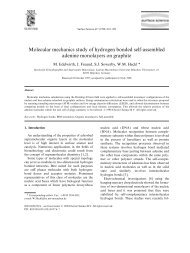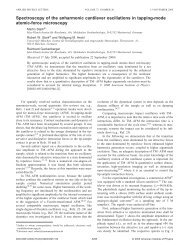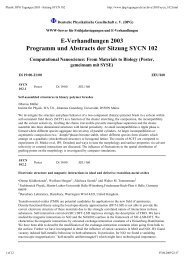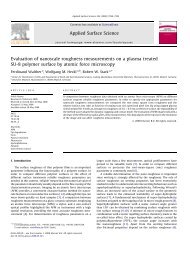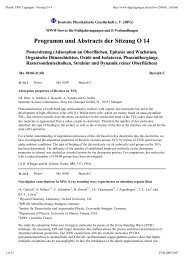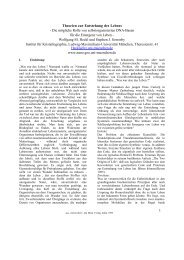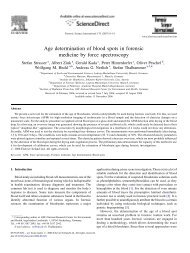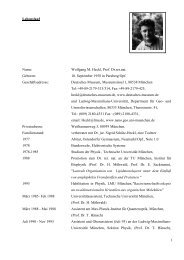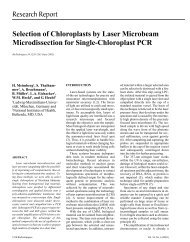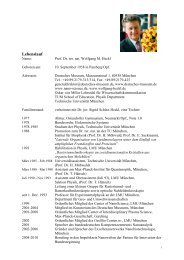Physik: DPG Tagungen - Sitzung O 28 - Nano-science.de
Physik: DPG Tagungen - Sitzung O 28 - Nano-science.de
Physik: DPG Tagungen - Sitzung O 28 - Nano-science.de
Create successful ePaper yourself
Turn your PDF publications into a flip-book with our unique Google optimized e-Paper software.
<strong>Physik</strong>: <strong>DPG</strong> <strong>Tagungen</strong> - <strong>Sitzung</strong> O <strong>28</strong><br />
http://www.dpg-tagungen.<strong>de</strong>/archive/2004/o_<strong>28</strong>.html<br />
BESSY II also exhibit <strong>de</strong>tailed information about the oxidation processes in such materials. In Al 0.98 Sn 0.02 we<br />
have <strong>de</strong>tected small differences in the binding energy of the Al 2p XPS peak of 30-50 meV that could be related<br />
to different grain orientations. We also present data taken on the nanowire prototype system Cu/ZnSe 2 [3]<br />
where the Cu-nanowires are effectively protected against oxidation even during air-exposure. Using cicular<br />
polarization at the undulator we were able to map magnetic domains [4] in a Fe single crystal at the Fe 2p XPS<br />
core-level with high contrast.<br />
[1] D. Funnemann et al., Bessy Annual Report, 2002<br />
[2] S. Schmidt et al., Bessy Annual Report, 2002<br />
[3] R. A<strong>de</strong>lung et. al, Adv. Mater. 14, 15, p.<br />
[1056-1061, 2002 4] C. Schnei<strong>de</strong>r et al., Rep. Prog. Phys, 65, R1785-R1839, 2002<br />
O <strong>28</strong>.52 Poster Mi 16:00 Bereich C<br />
Lead on hydrogen terminated Si(111): A comparison of two different <strong>de</strong>position techniques<br />
•C. Rettig 1,2 , H. Hövel 1 , V. Chamard 1 , S. Warren 2 , T. H. Metzger 2 und J. Zegenhagen 2<br />
1 Universität Dortmund, Experimentelle <strong>Physik</strong> I, D-44221 Dortmund (Germany)<br />
2 European Synchrotron Radiation Facility (ESRF), B.P. 220, F-38043 Grenoble (France)<br />
We studied the epitaxy of electrochemically <strong>de</strong>posited Pb clusters on Si(111):H <strong>de</strong>pen<strong>de</strong>nt on the applied<br />
overpotential. The former measurements [1] and the present investigations are carried out in-situ using Cyclic<br />
Voltammograms and Surface X-ray Diffraction (SXRD). The specular measurements show a predominant<br />
alignment of the Pb(111) plane parallel to the Si(111) plane. In the sample plane the Pb Clusters are aligned<br />
along the high symmetry direction of Si confirmed by Grazing Inci<strong>de</strong>nce Diffraction (GID). New results<br />
indicate a <strong>de</strong>pen<strong>de</strong>ncy of the Pb clusters alignment in the sample plane on the applied overpotential. Presently we<br />
extend our measurements to Ultra High Vacuum (UHV) environment with in-situ <strong>de</strong>position of Pb on Si(111):H.<br />
This system is studied by Scanning Tunneling Microscopy/Spectroscopy (STM/STS), Low Energy Electron<br />
Diffraction (LEED) and Ultraviolet Photoelectron Spectroscopy (UPS).<br />
[1] J. C. Ziegler et al., Surf. Sci. 452, 150 (2000).<br />
O <strong>28</strong>.53 Poster Mi 16:00 Bereich C<br />
Lifetime of particle plasmon excitation in Ag-<strong>Nano</strong>particles<br />
•Daniela Bayer, Alexan<strong>de</strong>r Mönnich, Jörg Lange, Michael Bauer und Martin Aeschlimann<br />
Dep. of Physics, University of Kaiserslautern<br />
The dynamics of photoexcited hot electrons are of special interest for a large variety of mo<strong>de</strong>rn fields such as<br />
fs-photochemistry and (magneto)electronics. These specific applications <strong>de</strong>pend critically on the inelastic<br />
lifetime T 1 of these hot electrons. Hence, the question arises if it would be possible to manipulate T 1 in a<br />
specific way. In this poster, we will <strong>de</strong>monstrate that the specific structuring of the material on a nanometer<br />
scale can govern the effective electron dynamics. Our interest is focused on localized collective oszillations of<br />
the electron gas in metal particles of nanometer size, the so-called particle plasmons. A. Liebsch predicts that<br />
un<strong>de</strong>r certain conditions the plasmon <strong>de</strong>phasing time at off-resonance excitation can be longer than on<br />
resonance due to the wavelength <strong>de</strong>pen<strong>de</strong>nce of radiation damping. Making use of the Time-Resolved<br />
Two-Photon-Photoemission (TR-2PPE), our investigation concentrates on elliptically shaped silver<br />
nano-particles un<strong>de</strong>r resonant and off-resonant conditions. Experimental results confirming Liebschs theory will<br />
be shown.<br />
O <strong>28</strong>.54 Poster Mi 16:00 Bereich C<br />
19 of 32 07.06.2009 22:14



